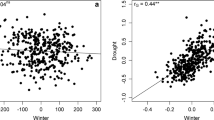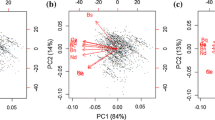Abstract
This work addresses to the genetic analysis and selection in populations where the whole genotypic value is transmitted through generations, using grapevine yield data as a case study. Several models were applied to different types of data sets. The individual and mean year yield and the balanced and unbalanced data resulting from various experimental designs (completely randomized, randomized complete block and row–column) were used. The aims of present work were to study: (1) the applicability of a generalised measure of broad-sense heritability to evaluate the success of the genotypic selection and compare it with the classical approach; and (2) the effect of different models on the accuracy and precision of the genotypic variance component and on the generalised broad-sense heritability estimates. The results showed that the computation of a measure of generalised broad-sense heritability is very feasible and useful for evaluating the efficiency of genotypic selection. In this study, 88 % of the fitted models did not comply with the standards for applying the classical concept of heritability. The differences between both the classical and generalised broad-sense heritability estimates increased with the complexity of the model. Higher broad-sense heritability estimates were consistently obtained with the mean years. The most accurate and precise estimates of the genetic parameters were obtained with the spatial models. Finally, the genotypic variance component of yield and the generalised broad-sense heritability were consistently significant for all grapevine varieties.
Similar content being viewed by others
References
Anderson TW (1984) An introduction to multivariate statistical analysis, 2nd edn. Wiley, New York
Bioletti FT (1926) Selection of planting stock for vineyards. Hilgardia 2(1):1–23
Cullis BR, Smith AB, Coombes NE (2006) On the design of early generation variety trials with correlated data. J Agr Biol Envir St 11:381–393
Falconer DS, Mackay TFC (1996) An introduction to quantitative genetics, 4th edn. Prentice Hall, London
Gilmour AR, Gogel BL, Cullis BR, Thompson R (2009) ASReml User Guide Release 3.0 VSN International Ltd, Hemel Hempstead
Gonçalves E, Martins A (2011) Genetic variability evaluation and selection in ancient grapevine varieties cap, Chap. 15. In: Abdurakhmonov IY (ed) Plant breeding. Intech, Rijeka, pp 333–352
Gonçalves E, St. Aubyn A, Martins A (2007) Mixed spatial models for data analysis of yield on large grapevine selection field trials. Theor Appl Genet 115:653–663
Gonçalves E, St. Aubyn A, Martins A (2010) Experimental designs for evaluation of genetic variability and selection of ancient grapevine varieties: a simulation study. Heredity 104: 552-562
Henderson CR (1975) Best linear unbiased estimation and prediction under a selection model. Biometrics 31:423–447
Jennrich RI, Sampson PF (1976) Newton–Raphson and related algorithms for maximum likelihood variance component estimation. Technometrics 18:11–17
Martins A (2007) Variabilidade genética intravarietal das castas. In: Böhm J (ed) Portugal vitícola, o grande livro das castas. Chaves Ferreira Publicações, Lisboa, pp 53–56
Martins A, Carneiro L, Castro R (1990) Progress in mass and clonal selection of grapevine varieties in Portugal. In: Proceedings of the 5th international simposium on grape breeding, Vitis (special issue), pp 485–489
McLean RA, Sanders WL, Stroup WW (1991) A unified approach to mixed linear models. The American Statistician 45:54–63
Morrison DF (1976) Multivariate statistical methods, 2nd edn. McGraw-Hill, Inc., New York
Myles S, Boyko A, Owens C, Brown P, Grassi F, Aradhya M, Prins B, Reynolds A, Chia J-M, Ware D, Bustamante C, Buckler E (2011) Genetic structure and domestication history of the grape. PNAS 108(9):3530–3535
Oakey H, Verbyla A, Pitchford W, Cullis B, Kuchel H (2006) Joint modelling of additive and non-additive genetic line effects in single field trials. Theor Appl Genet 113:809–819
Patterson HD, Thompson R (1971) Recovery of inter-block information when block sizes are unequal. Biometrika 58:545–554
Pelsy F, Hocquigny S, Moncada X, Barbeau G, Forget D, Hinrichsen P, Merdinoglu D (2010) An extensive study of the genetic diversity within seven French wine grape variety collections. Theor Appl Genet 120:1219–1231
Piepho HP, Möhring J (2007) Computing heritability and selection response from unbalanced plant breeding trials. Genetics 177:1881–1888
Rives M (1961) Bases génétiques de la sélection clonale chez la vigne. Ann Amélior Plantes 11(3):337–348
Rives M (1971) Génétique et amélioration de la vigne. In: Ribereau-Gayon J, Peynaud E (eds) Traité d’ampélologie. Sciences et Techniques de la vigne, Dunod, pp 171–219
Robinson GK (1991) That BLUP is a good thing: the estimation of random effects. Stat Sci 6:15–51
Sartorius O (1926) Zur Rebenselektionunter besonderer Berücksichtigung der Methodik under der Ziele auf Grund von 6–14 jährigen Beobachtungen an einem Klon. Z für Pflanzenz 11:31–74
Sartorius O (1928) Uber die wissenschaftlichen Grundlagen der Reben selektion in reinen Bestanden. Z für Pflanzenz 13:79–86
SAS Institute Inc. (2008) SAS/STAT® 9.2 User’s Guide. SAS Institute Inc: Cary, NC
Searle SR, Casella G, McCulloch CE (1992) Variance components. Wiley, New York
Self SG, Liang KY (1987) Asymptotic properties of maximum likelihood estimators and likelihood ratio tests under nonstandard conditions. J Am Stat Assoc 82:605–610
Steel RGD, Torrie JH (1960) Principles and procedures of statistics: a biometrical approach. McGraw-Hill, New York
Stram DO, Lee JW (1994) Variance components testing in the longitudinal mixed effects model. Biometrics 50:1171–1177
This P, Lacombe T, Thomas MR (2006) Historical origins and genetic diversity of wine grapes. Rev Trends Gene 22(9):511–519
Torregrosa L, Fernandez L, Bouquet A, Boursiquot J-M, Pelsy F, Martinez-Zapater JM (2011) Origins and consequences of somatic variation in grapevine. In: Adam-Blondon A-F, Martinez-Zapater JM, Chittaranjan K (eds) Genetics, genomics, and breeding of grapes. Science Publishers, CRC Press, Boca Raton pp 68–92
Welham SJ, Gogel BJ, Smith AB, Thompson R, Cullis BR (2010) A comparison of analysis methods for late-stage variety evaluation trials. Aust N Z J Stat 52:125–149
Acknowledgments
We are grateful to our colleagues of “National Network for Grapevine Selection” for their help in data collection. This work was suported by “Fundação para a Ciência e Tecnologia, Portugal” (BPD/43218/2008; PEst-OE/AGR/UI0240/2011).
Author information
Authors and Affiliations
Corresponding author
Rights and permissions
About this article
Cite this article
Gonçalves, E., Carrasquinho, I., St. Aubyn, A. et al. Broad-sense heritability in mixed models for grapevine initial selection trials. Euphytica 189, 379–391 (2013). https://doi.org/10.1007/s10681-012-0787-9
Received:
Accepted:
Published:
Issue Date:
DOI: https://doi.org/10.1007/s10681-012-0787-9




